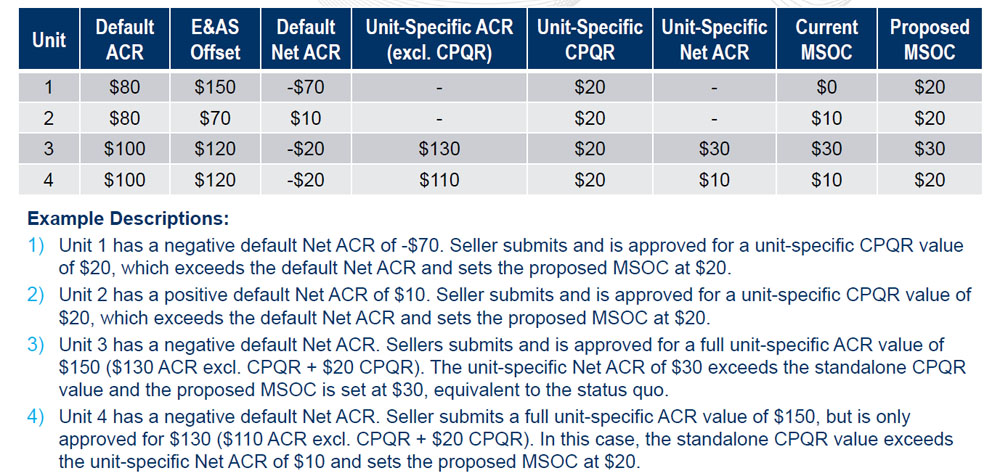PJM’s proposal to change its market seller offer cap (MSOC) fell short of the two-thirds endorsement threshold Wednesday as load sector stakeholders expressed concern over its impact on capacity prices.
The proposal, which would ensure sellers are always able to represent the cost of their Capacity Performance (CP) risk when offering into the capacity auction, won only 60.4% support in a sector-weighted vote of the Markets and Reliability Committee following more than an hour of debate.
 PJM hoped to win stakeholder and FERC approval of the revised market seller offer cap (MSOC) in time for its next Base Residual Auction in December. | PJM
PJM hoped to win stakeholder and FERC approval of the revised market seller offer cap (MSOC) in time for its next Base Residual Auction in December. | PJMThe rule change would set the MSOC at the greater of the CP quantifiable risk (CPQR) or net avoidable-cost rate (ACR) inclusive of CPQR.
PJM, which sponsored the proposal in response to requests from generators, said it would address circumstances in which a unit with a positive CPQR value has that cost offset by an otherwise negative net ACR, which could result in a $0 offer cap.
PJM had hoped to win stakeholder and FERC approval for the change effective with the 2024/25 capacity auction in December. After the vote, Adam Keech, PJM vice president of market services, said staff hadn’t had “real material discussions” on whether to recommend the Board of Managers file the proposal without stakeholder approval.
American Municipal Power’s Steve Lieberman said he was “extremely disappointed” with the way the issue was “shepherded” through the Resource Adequacy Senior Task Force, rejecting PJM’s characterization of it as a “narrow” change. (See “Stakeholders Wary of ‘Narrow’ Change to Market Seller Offer Cap,” PJM Markets and Reliability Committee Briefs: June 29, 2022.)
Lieberman said the proposal would be “a major change” to the Reliability Pricing Model and was proposed in response to the low prices in the last Base Residual Auction in June, when capacity prices dropped by one-third to almost one-half. (See PJM Capacity Prices Crater.)
 Examples of market seller offer caps (MSOC) under current rules and under PJM’s proposal | PJM
Examples of market seller offer caps (MSOC) under current rules and under PJM’s proposal | PJM
He said AMP is willing to consider changes to the MSOC as part of a “holistic” review of capacity market rules.
PJM’s Pat Bruno said CPQR is defined in the tariff as part of ACR and must be “quantifiable and reasonably supported.”
 Steve Lieberman, American Municipal Power | PJM
Steve Lieberman, American Municipal Power | PJM“It’s still supposed to reflect the market sellers’ evaluation of the risk,” he said.
Independent Market Monitor Joe Bowring said it is impossible to evaluate the impact of the CPQR change without understanding how PJM would interpret “reasonable support.”
“This is a very significant change to the concept of what the MSOC is,” he said. Removing a part of the ACR “simply is not logical and doesn’t make sense.
“There’s no issue that requires a short-term solution. We think this is a bad idea. It’s not narrow. It should be part of a broader package.”
Jeff Whitehead, of GT Power Group, said stakeholder concerns that the rule change would set a minimum capacity “floor” price would be addressed by PJM and IMM reviews of the generator filings.
“I don’t believe it does [create a floor. But] as long as it’s supported … it’s not inappropriate that a new floor would be created,” said Whitehead, who said he asked PJM to pursue the change.
“Unfortunately, a holistic approach went out the window with the MOPR,” he added, referring to FERC’s order effectively eliminating the minimum offer price rule for subsidized generation.
 Jeff Whitehead, GT Power Group | © RTO Insider LLC
Jeff Whitehead, GT Power Group | © RTO Insider LLC“This is a fair and simple reform, despite what the opponents are going to claim,” said Jason Barker, of Constellation. “People have said this is a response to the last auction. It’s not. This is a longstanding issue.”
Susan Bruce, representing the PJM Industrial Customer Coalition, said allowing market sellers to reflect their risks in their offers “is a concept that’s hard to say no to.”
But she said her group would oppose the change without more certainty over the CPQR definition. “We don’t know the size of the breadbox,” she said.
Carl Johnson, representing the PJM Public Power Coalition, said he could not recommend his members support the measure.
Greg Poulos, executive director of the Consumer Advocates of PJM States, said most of his members would not support the change because of the “piecemeal” nature of the proposal.
Erik Heinle, however, said the D.C.’s Office of the People’s Counsel would support the change, saying Whitehead and others had identified a “legitimate issue with the current construct.”
He noted that wind generators cleared 434 MW less in the last auction than the previous one, a drop of 25%. “We certainly recognize the impact of this rule change on intermittent resources that often have very low ACRs and very high CPQRs. That was a major part of our thinking on this issue,” he said.
Although he said more discussion is needed on the “parameters” of CPQR, he said his office is confident that the change wouldn’t undermine PJM and the IMM’s ability to prevent exercises of market power.
Bowring wasn’t so confident.
“There’s no good information on how high [the CPQR] could be or the impact on the clearing price without knowing PJM’s rules,” Bowring said. Expecting the IMM to prevent market power “cannot happen if the rules are bad.”



